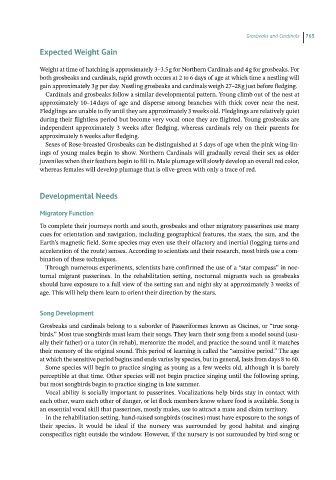Page 762 - Hand rearing birds second
P. 762
Grosbeaks and Cardinals 765
ExpectedWeightGain
Weight at time of hatching is approximately 3–3.5 g for Northern Cardinals and 4 g for grosbeaks. For
both grosbeaks and cardinals, rapid growth occurs at 2 to 6 days of age at which time a nestling will
gain approximately 3 g per day. Nestling grosbeaks and cardinals weigh 27–28 g just before fledging.
Cardinals and grosbeaks follow a similar developmental pattern. Young climb out of the nest at
approximately 10–14 days of age and disperse among branches with thick cover near the nest.
Fledglings are unable to fly until they are approximately 3 weeks old. Fledglings are relatively quiet
during their flightless period but become very vocal once they are flighted. Young grosbeaks are
independent approximately 3 weeks after fledging, whereas cardinals rely on their parents for
approximately 6 weeks after fledging.
Sexes of Rose‐breasted Grosbeaks can be distinguished at 5 days of age when the pink wing‐lin-
ings of young males begin to show. Northern Cardinals will gradually reveal their sex as older
juveniles when their feathers begin to fill in. Male plumage will slowly develop an overall red color,
whereas females will develop plumage that is olive‐green with only a trace of red.
DevelopmentalNeeds
MigratoryFunction
To complete their journeys north and south, grosbeaks and other migratory passerines use many
cues for orientation and navigation, including geographical features, the stars, the sun, and the
Earth’s magnetic field. Some species may even use their olfactory and inertial (logging turns and
acceleration of the route) senses. According to scientists and their research, most birds use a com-
bination of these techniques.
Through numerous experiments, scientists have confirmed the use of a “star compass” in noc-
turnal migrant passerines. In the rehabilitation setting, nocturnal migrants such as grosbeaks
should have exposure to a full view of the setting sun and night sky at approximately 3 weeks of
age. This will help them learn to orient their direction by the stars.
SongDevelopment
Grosbeaks and cardinals belong to a suborder of Passeriformes known as Oscines, or “true song-
birds.” Most true songbirds must learn their songs. They learn their song from a model sound (usu-
ally their father) or a tutor (in rehab), memorize the model, and practice the sound until it matches
their memory of the original sound. This period of learning is called the “sensitive period.” The age
at which the sensitive period begins and ends varies by species, but in general, lasts from days 8 to 60.
Some species will begin to practice singing as young as a few weeks old, although it is barely
perceptible at that time. Other species will not begin practice singing until the following spring,
but most songbirds begin to practice singing in late summer.
Vocal ability is socially important to passerines. Vocalizations help birds stay in contact with
each other, warn each other of danger, or let flock members know where food is available. Song is
an essential vocal skill that passerines, mostly males, use to attract a mate and claim territory.
In the rehabilitation setting, hand‐raised songbirds (oscines) must have exposure to the songs of
their species. It would be ideal if the nursery was surrounded by good habitat and singing
conspecifics right outside the window. However, if the nursery is not surrounded by bird song or

